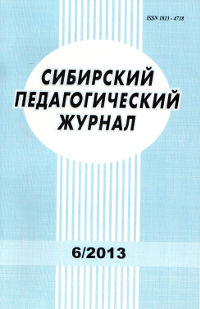Research activities in the university's scientific circle in the pedagogical legacy of Professor T. N. Troitskaya
1. Talent of the highest standard...: a collection of memoirs and research papers following the All-Russian scientific and practical conference dedicated to the 100th anniversary of the birth of the outstanding scientist and teacher, doctor of historical sciences, professor T. N. Troitskaya, 2025. Novosibirsk: Publishing house of NGPU, 173 p. (In Russ.)
2. Mzhelskaya, T. V., Durakov, I. A., Kationov, O. N., 2021. Model of teacher education in higher education: the pedagogical legacy of ProfessorT. N. Troitskaya. Philosophy of education, vol. 21, no. 1, pp. 143–159. (In Russ.)
3. Mzhelskaya, T. V., Durakov, I. A., Katio-nov, O. N., 2019. Pedagogical legacy of Professor T. N. Troitskaya: features of the learning process in a pedagogical university. Siberian pedagogical journal, no. 2, pp. 64–72. (In Russ.)
4. Molodin, V. I., Durakov, I. A., 2025. Introduction. Talent of the highest standard...: a collection of memoirs and research papers following the results of the All-Russian scientific and practical conference dedicated to the 100th anniversary of the birth of the outstanding scientist and teacher, doctor of historical sciences, professor T. N. Troitskaya. Novosibirsk: NSPU, pp. 4–6. (In Russ.)
5. Troitskaya, T. N., Silyanova, O. S., 2007. Student archaeological circle of NSPU: History and methods of work. Study guide. Novosibirsk: NSPU Publ.,72 p. (In Russ.)
6. Federal state educational standard of higher education – bachelor’s degree in the field of training 44.03.05 Pedagogical education (with two training profiles), approved by order of the Ministry of Education and Science of Russia dated February 22, 2018, no. 125. Available at: https://fgosvo.ru/uploadfiles/FGOS%20VO%203++/Bak/440305_B_3_16032018.pdf (accessed 05.20.2025). (In Russ.)
7. Morozova, O. P., 2023. Teacher as a researcher: professional training in the system of classical university education. Siberian pedagogical journal, no. 4, pp. 64–73. (In Russ.).
8. Bellack, Arno, A., 1981. Contrasting approaches to research on teaching. Studying Teaching and Learning, Trends in Soviet and American Research. N. Y., pp. 41–59. (In Eng.)
9. Nigmatov, Z. G., Shakirova, L. R. 2012.Theory and technology of teaching in higher education: A course of lectures. Kazan, 357 p. (In Russ.)
10. Kationov, O. N., 2010. Editor’s Word. Troitskaya T. N. My Calling. Novosibirsk: NSPU Publ., pp. 3–4. (In Russ.)
11. Mzhelskaya, T. V., Durakov, I. A., 2010. Archaeological practice: a look into the past, prospects for the future. Bulletin of pedagogical innovations, no. 3, pp. 132–140. (In Russ.)
12. Mzhelskaya, T. V., Durakov, I. A., 2014. Features of the research work of the archaeological club of the IIGSO NSPU at the present stage. Instead of a preface. Archaeological and ethnographic research in the educational space of NSPU: a collection of student scientific papers. Novosibirsk: NSPU Publ., pp. 4–9. (In Russ.)
13. Troitskaya, T. N. 2013. Museum through the eyes of an archaeologist. Novosibirsk: Yarus Publ., 59 p. (In Russ.)
14. Archaeological study of intercultural interactions: collection of student scientific works, 2012. Novosibirsk: NSPU Publ., 85 p. (In Russ.)
15. Archaeological and museum practices in the educational process of IIGSO: a collection of research papers, 2013. Novosibirsk: NSPU Publ., 144 p. (In Russ.)
16. Archaeological and ethnographic research in the educational space of NSPU: collection of student scientific works, 2014. Novosibirsk: NSPU Publ., 79 p. (In Russ.)
17. Troitskaya, T. N., 1990. Archaeological circle and its connections with student groups. Questions of the methodology of work of school archaeological circles: Methodological instructions. Novosibirsk, pp. 42–43. (In Russ.)
18. Troitskaya, T. N., 2014. My path of a teacher. Novosibirsk, 62 p. (In Russ.)
19. Troitskaya, T. N., 2010. My calling. Novosibirsk: NSPU Publ., 88 p. (In Russ.)
20. Seredenko, P. V., 2010. Preparation of future teachers for teaching students research skills. Bulletin of Moscow State Pedagogical Univ. Series: Pedagogy and Psychology, no. 1 (11), pp. 8–16. (In Russ.)




